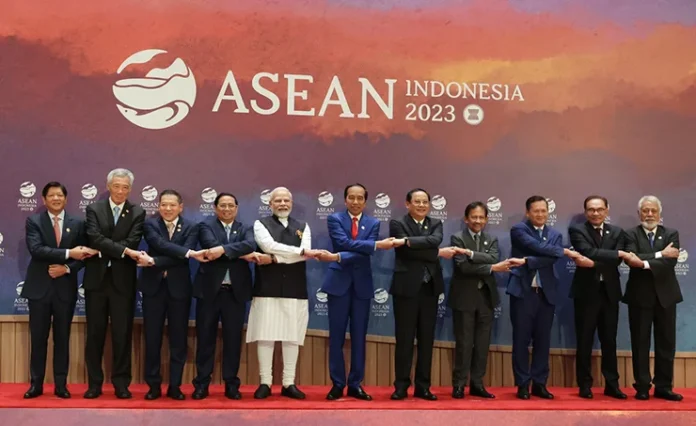ASEAN centrality is a key term mentioned in Prime Minister Narendra Modi’s statement during the 20th ASEAN Summit held in Jakarta, Indonesia on September 7, 2023. The central question is how to define ASEAN centrality. This term has appeared in documents from the 2nd East Asian Summit (EAS), the 10th ASEAN Plus Three (APT) Summit, and the 12th ASEAN Summit (2007). It is used to portray ASEAN as the “leader,” the “driver,” the “architect,” the “institutional hub,” the “vanguard,” the “nucleus,” and the “fulcrum” of regional processes and institutional designs in the Asia-Pacific region. The ASEAN Charter refers to it as the “primary driving force” in the wider East Asian and Asia-Pacific region. ASEAN centrality is shaped not only by ASEAN members but also by external players in Southeast Asia.
According to Amitav Acharya, a renowned scholar in international relations, ASEAN centrality means that ASEAN lies at the core of regional institutions in Asia (or the Asia-Pacific), especially the APT, ASEAN Regional Forum (ARF), and the EAS. ASEAN provides the institutional “platform” on which broader regional institutions in the Asia Pacific and East Asia are built. In other words, constructing these broader regional bodies would not have been possible without ASEAN.
India’s Strategic Partnership with ASEAN
In November 2022, India elevated its 30-year relationship with ASEAN to a comprehensive strategic partnership. Prime Minister Narendra Modi reaffirmed that ASEAN is the central pillar of India’s Act East Policy. Historical ties, geographical proximity, shared values, and regional unity connect India and ASEAN. To strengthen this strategic partnership, India and ASEAN welcomed the adoption of the Annex to the Plan of Action to Implement the ASEAN-India Partnership for Peace, Progress, and Shared Prosperity (2021-2025).
Joint Statements on Key Issues
At the end of the ASEAN summit, joint statements were issued on maritime security and food security and nutrition in response to the post-COVID 19 world order challenges. The joint statement on maritime cooperation between India and ASEAN broadly covers cooperation in the blue economy, enhancing maritime safety, improving research on marine technology, and collaborating on actions to prevent and reduce marine debris in the Indo-Pacific region. The joint statement on food security and nutrition commits to increasing concerted efforts between ASEAN and India to maintain food supply chains despite disruptions and collaborate on rapid actions to strengthen food security and nutrition in crisis situations, including ensuring the unimpeded trade and flow of foodstuffs and essential agricultural inputs.
India’s Vision for Connectivity
Furthermore, India presented a 12-point proposal to strengthen its partnership with ASEAN, focusing on connectivity, digital transformation, trade, and economic engagement. India proposed the idea of an economic corridor connecting Southeast Asia, India, and Europe, which experts view as a strategic response to China’s One Belt One Road Initiative (OBOR).
ASEAN centrality in the Indo-Pacific
During the summit, Prime Minister Modi reiterated India’s support for ASEAN centrality in the Indo-Pacific region. He highlighted the synergies between India’s Indo-Pacific Initiative and the ASEAN Outlook on Indo-Pacific (AOIP). The Indo-Pacific Oceans Initiative (IPOI) is an open initiative for all stakeholders in the Indo-Pacific region to collaboratively address common challenges. In contrast, the ASEAN Outlook on the Indo-Pacific (AOIP) envisions ASEAN Centrality as the guiding principle for promoting cooperation in the Indo-Pacific region, with ASEAN-led mechanisms such as the EAS serving as platforms for dialogue and cooperation, while maintaining their formats.
International Law and Territorial Integrity
At the 18th East Asia Summit, with Chinese Premier Li Qiang in attendance, East Asian leaders recognised the importance of a maritime regime in the region consistent with international law, including the 1982 United Nations Convention on the Law of the Sea (UNCLOS), which has contributed to the region’s impressive economic growth. Prime Minister Modi emphasised the need for nations to fully adhere to international law and the importance of strengthening the territorial integrity and sovereignty of countries. This was a clear message to China, which has been increasing its military presence in the South China Sea amid recent controversies over new standard maps.
Commitment to Regional Growth
The East Asia Summit in Jakarta released a joint statement aiming to maintain the region as a centre of growth. The leaders decided to strengthen cooperation and partnership to ensure that the region remains relevant, competitive, inclusive, forward-looking, resilient, adaptive, and responsive to future regional and global challenges, in line with the ASEAN Leaders’ Declaration on ASEAN as a centre of growth and the implementation of the EAS Plan of Action (2024-2028).
Challenges and Rivalry
ASEAN centrality will become a reality, provided that there is greater cohesion and convergence of interests among its members. The rivalry between the Great Powers (United States and China) in the Indo-Pacific region has implications for ASEAN. While both the US and China continue to verbally support ASEAN centrality, their policies have not strengthened it.
Key Takeaways
ASEAN centrality stands as a cornerstone of regional stability and cooperation in the Indo-Pacific, and India’s commitment to this concept marks a strategic pivot in the geopolitical chessboard. Prime Minister Modi emphasised that ASEAN is a focal point of the QUAD vision. The QUAD consists of the US, India, Japan, and Australia, with a focus on cooperation to ensure a free and open Indo-Pacific region. In an era marked by competing powers and complex challenges, the centrality of ASEAN remains a beacon of hope for a harmonious and prosperous Indo-Pacific.
-The writer is an Assistant Professor at the School of Law, Presidency University, Bangalore. The views expressed herein are those of the author and do not necessarily reflect the views of Raksha Anirveda





